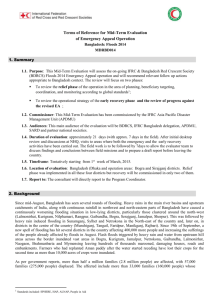Press release - CCAFS
advertisement
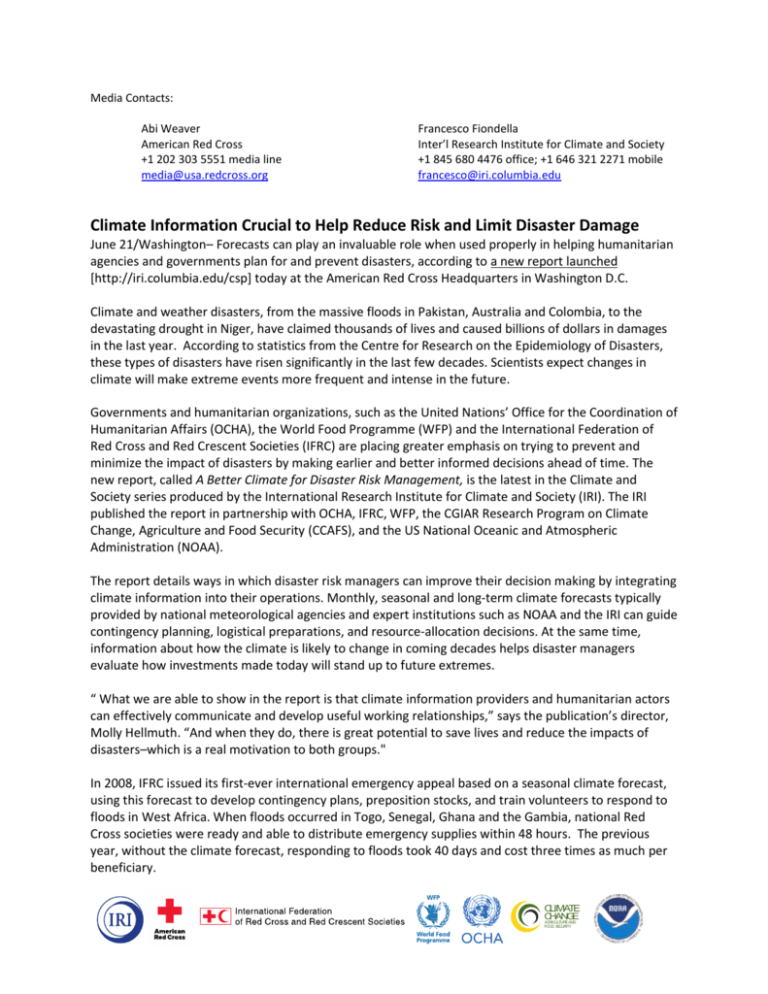
Media Contacts: Abi Weaver American Red Cross +1 202 303 5551 media line media@usa.redcross.org Francesco Fiondella Inter’l Research Institute for Climate and Society +1 845 680 4476 office; +1 646 321 2271 mobile francesco@iri.columbia.edu Climate Information Crucial to Help Reduce Risk and Limit Disaster Damage June 21/Washington– Forecasts can play an invaluable role when used properly in helping humanitarian agencies and governments plan for and prevent disasters, according to a new report launched [http://iri.columbia.edu/csp] today at the American Red Cross Headquarters in Washington D.C. Climate and weather disasters, from the massive floods in Pakistan, Australia and Colombia, to the devastating drought in Niger, have claimed thousands of lives and caused billions of dollars in damages in the last year. According to statistics from the Centre for Research on the Epidemiology of Disasters, these types of disasters have risen significantly in the last few decades. Scientists expect changes in climate will make extreme events more frequent and intense in the future. Governments and humanitarian organizations, such as the United Nations’ Office for the Coordination of Humanitarian Affairs (OCHA), the World Food Programme (WFP) and the International Federation of Red Cross and Red Crescent Societies (IFRC) are placing greater emphasis on trying to prevent and minimize the impact of disasters by making earlier and better informed decisions ahead of time. The new report, called A Better Climate for Disaster Risk Management, is the latest in the Climate and Society series produced by the International Research Institute for Climate and Society (IRI). The IRI published the report in partnership with OCHA, IFRC, WFP, the CGIAR Research Program on Climate Change, Agriculture and Food Security (CCAFS), and the US National Oceanic and Atmospheric Administration (NOAA). The report details ways in which disaster risk managers can improve their decision making by integrating climate information into their operations. Monthly, seasonal and long-term climate forecasts typically provided by national meteorological agencies and expert institutions such as NOAA and the IRI can guide contingency planning, logistical preparations, and resource-allocation decisions. At the same time, information about how the climate is likely to change in coming decades helps disaster managers evaluate how investments made today will stand up to future extremes. “ What we are able to show in the report is that climate information providers and humanitarian actors can effectively communicate and develop useful working relationships,” says the publication’s director, Molly Hellmuth. “And when they do, there is great potential to save lives and reduce the impacts of disasters–which is a real motivation to both groups." In 2008, IFRC issued its first-ever international emergency appeal based on a seasonal climate forecast, using this forecast to develop contingency plans, preposition stocks, and train volunteers to respond to floods in West Africa. When floods occurred in Togo, Senegal, Ghana and the Gambia, national Red Cross societies were ready and able to distribute emergency supplies within 48 hours. The previous year, without the climate forecast, responding to floods took 40 days and cost three times as much per beneficiary. CLIMATE C HANGE AGRICULTUREAND FOOD SECURITY A Better Climate for Disaster Risk Management details this and 16 other examples including: integrating rainfall and hurricane forecasts into planning in post-earthquake Haiti; using climate information to increase long-term food security in Kenya; and using games to help humanitarian workers better understand how to use complex climate information. The key lessons and recommendations in the report include: Weather and climate information, especially seasonal forecasts, can be used to help reduce the impacts of disasters by informing preparedness, disaster prevention, and emergency response. Partnerships between climate scientists and disaster risk managers are essential to develop trust and create actionable information. “The best, actionable climate information arises out of a dialogue between climate scientists and disaster risk managers–it can’t be a one-way process,” says Maarten van Aalst of the Red Cross/Red Crescent Climate Centre, one of the report’s authors. “This requires investing in a relationship that promotes knowledge sharing, trust and creativity.” Climate information needs to be integrated into existing decision-making platforms to ensure disaster managers can use it in their daily activities and that it helps generate concrete action. Immediate gains can be made to improve disaster risk management in areas of the world where seasonal forecasts are more reliable, and where better-informed humanitarian decisions can provide relatively strong and immediate returns on investment. Better funding mechanisms linked to climate early warning are needed. Governments, humanitarian organizations and donors should provide stronger support for preparedness and prevention measures, including more systematic funding for early action based on relevant climate information. “We recognize that preventing and managing disasters is extremely complex and goes beyond just using climate information,” says IRI Director-General, Steve Zebiak. “However, in our partnership to save lives with the IFRC, we have seen the tangible value of improved preparedness when climate informs disaster-risk management.” # # # About the International Research Institute for Climate and Society The International Research Institute for Climate and Society (IRI), part of the Earth Institute at Columbia University, aims to enhance society’s ability to understand, anticipate and manage the impacts of climate in order to improve human welfare and the environment, especially in developing countries. From environmental monitoring and forecasting to climate-related risk management tools and practices in water resources, public health, agriculture, and food security, IRI and its partners focus on opportunities to build capacity for bringing climate information into regional planning and decision making. For more information, please visit http://iri.columbia.edu or follow @climatesociety on Twitter. About the American Red Cross The American Red Cross shelters, feeds and provides emotional support to victims of disasters; supplies nearly half of the nation's blood; teaches lifesaving skills; provides international humanitarian aid; and supports military members and their families. The Red Cross is a charitable organization — not a government agency — and depends on volunteers and the generosity of the American public to perform CLIMATE C HANGE AGRICULTUREAND FOOD SECURITY its mission. For more information, please visit www.redcross.org or join our blog at http://blog.redcross.org. About the IFRC The International Federation of Red Cross and Red Crescent Societies (IFRC) is the world's largest humanitarian organization, with 186 member National Societies. As part of the International Red Cross and Red Crescent Movement, our work is guided by seven fundamental principles; humanity, impartiality, neutrality, independence, voluntary service, unity and universality. For more information, go to www.ifrc.org. About the World Food Programme WFP is the world's largest humanitarian agency fighting hunger worldwide. Each year, on average, WFP feeds more than 90 million people in more than 70 countries. For more information, go to www.wfp.org. About OCHA OCHA is the part of the United Nations Secretariat responsible for bringing together humanitarian actors to ensure a coherent response to emergencies. OCHA also ensures there is a framework within which each actor can contribute to the overall response effort. OCHA's mission is to mobilize and coordinate effective and principled humanitarian action in partnership with national and international actors in order to alleviate human suffering in disasters and emergencies; to advocate the rights of people in need; to promote preparedness and prevention; and to facilitate sustainable solutions. For more information, go to www.unocha.org About CCAFS The CGIAR Research Program on Climate Change, Agriculture and Food Security (CCAFS) is a strategic partnership of the CGIAR and the Earth System Science Partnership (ESSP). CCAFS brings together the world’s best researchers in agricultural science, development research, climate science and Earth System science, to identify and address the most important interactions, synergies and tradeoffs between climate change, agriculture and food security. The CGIAR Lead Center of the program is the International Center for Tropical Agriculture (CIAT) in Cali, Columbia. For more information, visit www.ccafs.cgiar.org. About NOAA The U.S. National Oceanic and Atmospheric Administration conducts research and gathers data about the global oceans, atmosphere, space, and sun, and applies this knowledge to science and service that touch the lives of all Americans. NOAA warns of dangerous weather, charts our seas and skies, guides our use and protection of ocean and coastal resources, and conducts research to improve our understanding and stewardship of the environment which sustains us all. For further information, please go to http://www.publicaffairs.noaa.gov. CLIMATE C HANGE AGRICULTUREAND FOOD SECURITY
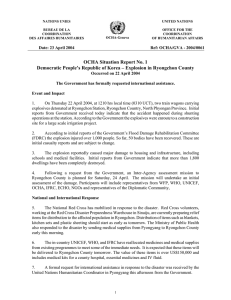



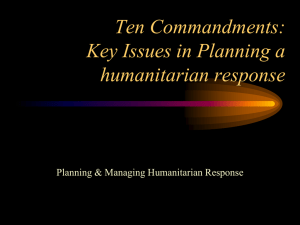



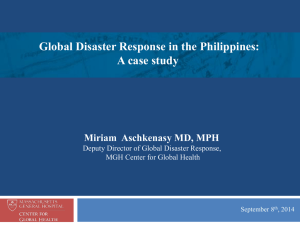
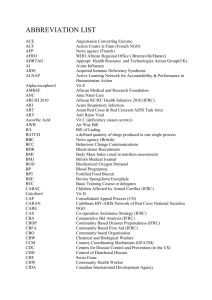
![Humanitarian aid and disaster relief feature article]](http://s3.studylib.net/store/data/007366231_1-ea74c75785ac7d73f5e03546ae3530b8-300x300.png)
